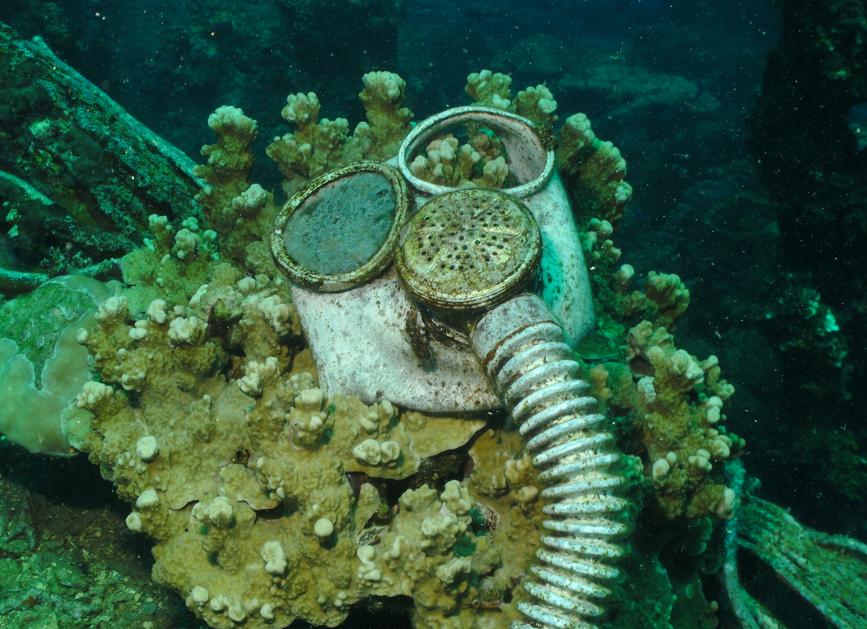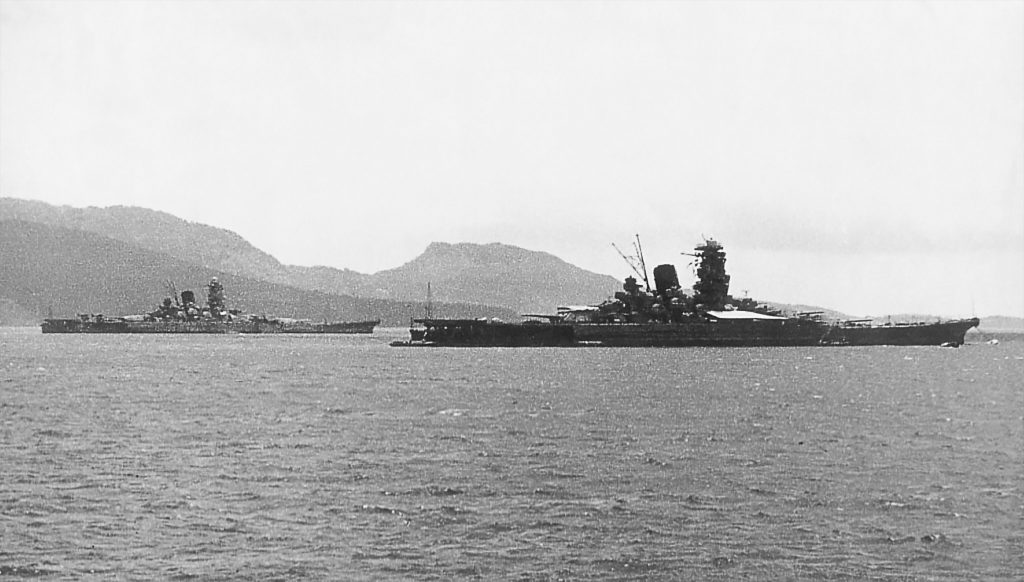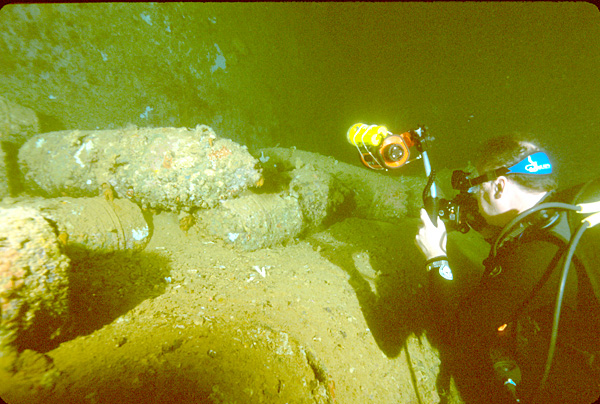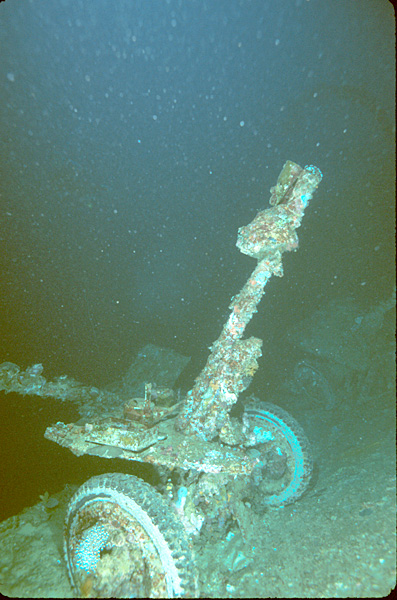Nestled in the heart of the Pacific, Chuuk Lagoon, formerly known as Truk Lagoon, harbors a hidden underwater trove that echoes the tumultuous events of World War II.

Once a formidable Japanese naval base, the lagoon is now a world-renowned dive site, famed for its sunken armada of ships and aircraft.
Background
Chuuk Lagoon, part of the Caroline Islands in the western Pacific Ocean, is an atoll—a large coral reef enclosing a lagoon.
The atoll’s formation began millions of years ago with volcanic activity, creating the high islands that now form the perimeter of the lagoon.
Over time, coral growth formed a barrier reef around these islands, creating a protected lagoon with calm, shallow waters.
This natural harbor spans approximately 40 miles in diameter, making it one of the largest lagoons in the world.
The combination of its size, the natural protection offered by the coral reef, and its strategic location in the central Pacific makes Chuuk Lagoon uniquely significant.
The islands within Chuuk Lagoon have been inhabited for centuries, with archaeological evidence suggesting human presence dating back to at least the 2nd millennium BC.
The indigenous Chuukese people developed a complex society structured around matrilineal clans.
The Chuukese built sturdy outrigger canoes, facilitating movement between the lagoon’s islands and beyond.
European contact with Chuuk Lagoon began in the 16th century, with Spanish explorers being the first Europeans to sight the islands.
However, sustained contact and significant European influence did not begin until the 19th century.
In the late 19th century, Spain formally claimed the Caroline Islands, including Chuuk Lagoon, but sold them to Germany in 1899 following the Spanish-American War.
Under German administration, Chuuk Lagoon saw the introduction of copra (dried coconut meat) production as a major economic activity.
However, Germany’s control was short-lived; Japan seized the Carolines during World War I.
In the interwar period, Japan received a mandate from the League of Nations to administer the islands, which they did until the outbreak of World War II.
 The Yamato (left) and Musashi (right) moored in Truk Lagoon, 1943.
The Yamato (left) and Musashi (right) moored in Truk Lagoon, 1943.
Japan’s administration of Chuuk Lagoon marked the beginning of its transformation from a remote, primarily indigenous society into a strategically important military site.
Recognizing the lagoon’s natural harbor and central location in the Pacific, the Japanese began to fortify the islands in the 1930s.
They built airfields, seaplane bases, and other military installations, preparing Chuuk Lagoon to play a pivotal role in their expansionist strategies in the Pacific.
‘Gibraltar Of The Pacific’
Truk Lagoon’s strategic value in the Pacific Theater of World War II cannot be overstated. Its location in the central Pacific made it an ideal staging and supply point for Japanese naval and air operations across a vast area, including critical campaigns in Southeast Asia and the South Pacific.
The natural protection offered by its surrounding reef and islands made it a formidable naval fortress, ideal for housing a significant portion of the Japanese Combined Fleet.
Under Japanese control, Truk Lagoon underwent extensive militarization.
Japan constructed sophisticated fortifications, including numerous airfields, naval bases, communication centers, and support facilities.
By the early 1940s, Truk had become one of the most heavily defended fortresses in the Pacific, equipped with anti-aircraft guns, coastal artillery, and minefields.
The lagoon housed battleships, aircraft carriers, cruisers, destroyers, submarines, and auxiliary ships, along with a significant number of aircraft.
Truk Lagoon served as the primary forward operational base for the Imperial Japanese Navy.
It was a critical logistical hub, supporting Japanese offensives and providing maintenance and resupply capabilities for naval and air units.
The lagoon’s facilities allowed for repairs, refueling, and rearming of ships and planes, enabling sustained Japanese military operations across the Pacific.
It was often referred to as the “Gibraltar of the Pacific” due to its formidable defenses and significant military presence.
The most significant event in Chuuk Lagoon’s World War II history was Operation Hailstone, executed by the United States Navy on February 17-18, 1944.
Recognizing Truk Lagoon’s importance to Japanese war efforts, the U.S. launched a massive surprise attack, involving carrier-based aircraft and surface ships.
Over two days, U.S. forces conducted continuous air raids, resulting in the sinking of more than 40 Japanese naval and merchant vessels and the destruction of 275 aircraft.
 Japanese ships in Truk Lagoon under attack during Operation Hailstone.
Japanese ships in Truk Lagoon under attack during Operation Hailstone.
Operation Hailstone marked a turning point in the Pacific War. It effectively crippled Truk Lagoon’s capacity as a Japanese naval base and significantly disrupted Japan’s ability to conduct maritime operations in the central and south Pacific.
The loss of ships, aircraft, and supplies, along with the damage to infrastructure, was a blow from which the Japanese Navy never fully recovered.
A Divers Paradise
After World War II, Chuuk Lagoon gained prominence as one of the world’s most extraordinary wreck diving locations. The lagoon’s floor is a veritable underwater museum.
In waters devoid of normal ocean currents, divers can easily swim across decks littered with gas masks and depth charges, and below decks can be found evidence of human remains.
In the massive ships’ holds are the remnants of fighter aircraft, tanks, bulldozers, railroad cars, motorcycles, torpedoes, mines, bombs, boxes of munitions, radios, plus thousands of other weapons, spare parts, and other artifacts.
Of special interest is the wreck of the submarine I-169 Shinohara which was lost when diving to avoid the bombing. The submarine had participated in the attack on Pearl Harbor in December 1941.
 A ‘Betty’ bomber wreck that lies at the bottom of Chuuk Lagoon. Image by Aquaimages CC BY-SA 2.5
A ‘Betty’ bomber wreck that lies at the bottom of Chuuk Lagoon. Image by Aquaimages CC BY-SA 2.5
These wrecks, many of which are in relatively shallow waters and remarkably well-preserved, offer a unique and haunting diving experience.
The site provides a vivid and tangible link to World War II, making it a bucket-list destination for history enthusiasts and scuba divers alike.
While the wrecks of Chuuk Lagoon are an invaluable resource for divers and historians, they also pose significant environmental challenges.
Many of the sunken ships still contain oil, fuel, and other hazardous materials that could leak into the lagoon, potentially causing significant ecological damage.
Chuuk Lagoon serves as a somber reminder of the tragedies of war. The site is not just a recreational spot but a place of historical reflection and commemoration. Many of the wrecks are considered war graves, with the remains of Japanese sailors still onboard.
Gallery
 A bow gun on board the Fujikawa Maru. Image by Aquaimages CC BY-SA 2.5
A bow gun on board the Fujikawa Maru. Image by Aquaimages CC BY-SA 2.5
 Artillery shells on board the Yamagiri Maru. Image by Aquaimages CC BY-SA 2.5
Artillery shells on board the Yamagiri Maru. Image by Aquaimages CC BY-SA 2.5
 A very eerie shot of a gas mask on board the Fujikawa Maru. Image by Aquaimages CC BY-SA 2.5
A very eerie shot of a gas mask on board the Fujikawa Maru. Image by Aquaimages CC BY-SA 2.5
 A Japanese tank on board the Nippo Maru. Image by Aquaimages CC BY-SA 2.5
A Japanese tank on board the Nippo Maru. Image by Aquaimages CC BY-SA 2.5
 An artilliery piece on board the Nippo Maru. Image by Aquaimages CC BY-SA 2.5
An artilliery piece on board the Nippo Maru. Image by Aquaimages CC BY-SA 2.5
 A military truck on board the Hoki Maru. Image by Aquaimages CC BY-SA 2.5
A military truck on board the Hoki Maru. Image by Aquaimages CC BY-SA 2.5
News
Miley Cyrus N-de & S*xy Collection (10 Photos)
Miley Cyrus, the American Fappening celeb, is in a new set of nude and sexy pics, showin’ off her stuff! Instagram: https://www.instagram.com/mileycyrus/
Exactly 6 years ago, Taylor Swift’s “MV that made the audience talk a lot” Delicate was released globally.
After exactly 1 year and 4 months of release, Taylor Swift’s “Look What You Make Me Do” has officially reached 1 billion views on YouTube. On December…
Sylvester Stallone’s model daughter Sistine, 17, looks just like her mother Jennifer Flavin, 46, as they step out in matching denim shorts in Antibes
Sylvester Stallone is currently soaking up the sun in Antibes, France, with his stunning wife and daughters and the family resemblance is clear to see. The Rocky…
Miley Cyrus’ Fans Speculate That She Got ‘Plastic Surgery’ After Seeing Before-And-After Photos From 2012 To 2024
Miley Cyrus has evolved from a Disney darling to a full-fledged rockstar, and many of her fans feel like they’ve grown up with her. Over time, the “Flowers”…
Arnold Schwarzenegger spotted filming Netflix series in Elora
Arnold Schwarzenegger, the illustrious bodybuilder, action star, and former governor, can now add another highlight to his extensive résumé: a visit to Elora. Schwarzenegger was spotted on…
Arnold Schwarzenegger Was Honored As An Outstanding Bodybuilder Who Redefined The Perfect Physique
Arnold Schwarzenegger, the legendary seven-time Mr. Olympia, stands as the epitome of the bodybuilding realm, forever etched in history as the most influential bodybuilder of all time….
End of content
No more pages to load











